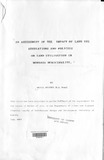| dc.contributor.author | Ngeti, Reuben | |
| dc.date.accessioned | 2013-06-07T09:13:54Z | |
| dc.date.available | 2013-06-07T09:13:54Z | |
| dc.date.issued | 1997 | |
| dc.identifier.citation | A thesis submitted in partial fulfilment for the degree of masters of Arts (Planning) in t.h e Department of Urban and Regio~Rl Planning, University of Nairobi. | en |
| dc.identifier.uri | http://erepository.uonbi.ac.ke:8080/xmlui/handle/123456789/29903 | |
| dc.description.abstract | Land use regulations in developing countries often fail to achieve
greater efficiency and equity in the use of urban land. As a result. plans often bear little or no relation to the peoples needs and wishes and they are in any case distorted by limited implementation. These problems are exacerbated. particularly in the face of rapid change,by lack of consistent
overall policy framework and mechanisms for resolving conflicts between different objectives.
This study examines the impact of land use regulations and policies
o n la n d utilization in Mombasa municipality a n d the focus was on the problem or' uncontrolled developments in the municipality in relation to the existing land us e control and policies. All assumption was made that the regulatory policies have been the main influence on the emerging development pattern in Mombasa.It was also assumed that the u n coordinate d developments might have been caused by the prevailing land tenure system.
The study objectives were thus to find out the role land use
regulations and policies.have played in the emergent urban development structure of Mombasa: to find out the level of involvement of the
municipality in development control over Mombasa past and present land use structure : and ultimately to propose a workable a approach to utilization of land use regulations in developing a sustainable urban structure in Mombasa.
The problem has been studied by looking at the historical
developments of the town, the nature of regulatory policies and other
planning legislation , and the capacity of the council to manage (use and control). and administer (allocate, register, and lease) land. Primary source of data included a field survey where a critical examination of the physical
developments in the municipality was done. interview schedules and
household questionnaire were also administered using a random sampling
procedure.It was found out that the existing regulatory policies have been ineffective in guiding development in the municipality and that the existing
land tenure system is a constraint to orderly development of the town. Out of the critical assessment of the above issues and the findings of the study , recommendations were made. The important conclusion made were
that.:
l ) The historical development of Mombasa has influenced present
development pattern.
2) It is difficult to control development on private land.
J) Inadequate finance and manpower coupled with inefficient land
management and administration by the council are major constraints
to development control.
4) The obsolete rigid inapplicable nature of control legislation has made development control impossible and. that
'5) Absence of advisory physical development plans for the whole or
part of the town compounds the problem.
The study recommends that there is an urgent need to prepare a
physical development plan(s) for the town, revise the regulatory policies and the plan n in g legislation and institute more stringent legal measures which should be enforced in collaboration with community . | |
| dc.language.iso | en | en |
| dc.title | An assessment of the impact of land use regulations and policies on land utilization in Mombasa Municipality. | en |
| dc.type | Thesis | en |
| local.publisher | Uban and regional planning, University of Nairobi | en |

